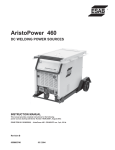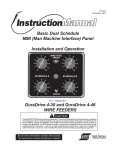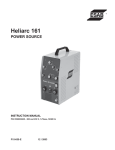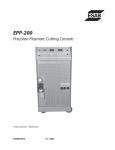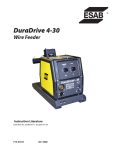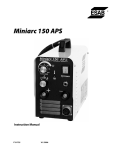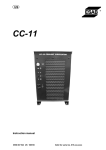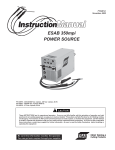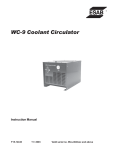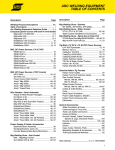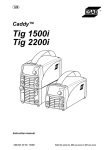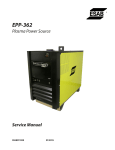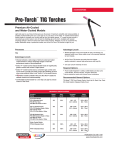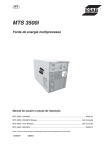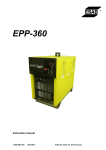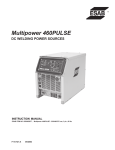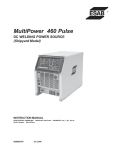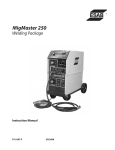Download ARISTODRIVE 4-30 & 4-48HD - ESAB Welding & Cutting Products
Transcript
ARISTODRIVE 4-30 & 4-48HD WIRE FEEDER INSTRUCTION MANUAL ESAB ITEM NO. 0558003275, AristoDrive 4-48 ESAB ITEM NO. 0558003276, AristoDrive 4-30 Revision B 0558003750 10 / 2003 BE SURE THIS INFORMATION REACHES THE OPERATOR These INSTRUCTIONS are for experienced operators. If you are not fully familiar with the principles of operation and safe practices for arc welding and cutting equipment, we urge you to read our booklet, "Precautions and Safe Practices for Arc Welding, Cutting, and Gouging," Form 52-529. Do NOT permit untrained persons to install, operate, or maintain this equipment. Do NOT attempt to install or operate this equipment until you have read and fully understand these instructions. If you do not fully understand these instructions, contact your supplier for further information. Be sure to read the Safety Precautions before installing or operating this equipment. USER RESPONSIBILITY This equipment will perform in conformity with the description thereof contained in this manual and accompanying labels and/or inserts when installed, operated, maintained and repaired in accordance with the instructions provided. This equipment must be checked periodically. Malfunctioning or poorly maintained equipment should not be used. Parts that are broken, missing, worn, distorted or contaminated should be replaced immediately. Should such repair or replacement become necessary, the manufacturer recommends that a telephone or written request for service advice be made to the Authorized Distributor from whom it was purchased. This equipment or any of its parts should not be altered without the prior written approval of the manufacturer. The user of this equipment shall have the sole responsibility for any malfunction which results from improper use, faulty maintenance, damage, improper repair or alteration by anyone other than the manufacturer or a service facility designated by the manufacturer. Copies of this manual can be obtained by any of the following; Contacting your local ESAB supplier. Downloading a copy from the ESAB web site at www.esabna.com Sending a written request to ESAB WELDING & CUTTING PRODUCTS ATTN: LITERATURE DEPT. 411 S EBENEZER ROAD FLORENCE SC 29501 2 TABLE OF CONTENTS SECTION PARAGRAPH TITLE PAGE 1 DESCRIPTION ...................................................................................................................... 11 2 INSTALLATION ..................................................................................................................... 19 3 OPERATION ......................................................................................................................... 23 4 TROUBLESHOOTING .......................................................................................................... 25 Schematic ............................................................................................................. 26 Wiring Diagram ..................................................................................................... 27 5 REPLACEMENT PARTS .......................................................................................................29 AristoDrive 4-30 .................................................................................................... 30 AristoDrive 4-48 .................................................................................................... 39 3 TABLE OF CONTENTS 4 SAFETY PRECAUTIONS WARNING: These Safety Precautions are for your protection. They summarize precautionary information from the references listed in Additional Safety Information section. Before performing any installation or operating procedures, be sure to read and follow the safety precautions listed below as well as all other manuals, material safety data sheets, labels, etc. Failure to observe Safety Precautions can result in injury or death. 5. Do not use equipment beyond its ratings. For example, overloaded welding cable can overheat and create a fire hazard. 6. After completing operations, inspect the work area to make certain there are no hot sparks or hot metal which could cause a later fire. Use fire watchers when necessary. 7. For additional information, refer to NFPA Standard 51B, "Fire Prevention in Use of Cutting and Welding Processes", available from the National Fire Protection Association, Batterymarch Park, Quincy, MA 02269. PROTECT YOURSELF AND OTHERS -Some welding, cutting, and gouging processes are noisy and require ear protection. The arc, like the sun, emits ultraviolet (UV) and other radiation and can injure skin and eyes. Hot metal can cause burns. Training in the proper use of the processes and equipment is essential to prevent accidents. Therefore: ELECTRICAL SHOCK -- Contact with live electrical parts and ground can cause severe injury or death. DO NOT use AC welding current in damp areas, if movement is confined, or if there is danger of falling. 1. Always wear safety glasses with side shields in any work area, even if welding helmets, face shields, and goggles are also required. 2. Use a face shield fitted with the correct filter and cover plates to protect your eyes, face, neck, and ears from sparks and rays of the arc when operating or observing operations. Warn bystanders not to watch the arc and not to expose themselves to the rays of the electric-arc or hot metal. 3. Wear flameproof gauntlet type gloves, heavy long-sleeve shirt, cuffless trousers, high-topped shoes, and a welding helmet or cap for hair protection, to protect against arc rays and hot sparks or hot metal. A flameproof apron may also be desirable as protection against radiated heat and sparks. 4. Hot sparks or metal can lodge in rolled up sleeves, trouser cuffs, or pockets. Sleeves and collars should be kept buttoned, and open pockets eliminated from the front of clothing 5. Protect other personnel from arc rays and hot sparks with a suitable non-flammable partition or curtains. 6. Use goggles over safety glasses when chipping slag or grinding. Chipped slag may be hot and can fly far. Bystanders should also wear goggles over safety glasses. 1. Be sure the power source frame (chassis) is connected to the ground system of the input power. 2. Connect the workpiece to a good electrical ground. 3. Connect the work cable to the workpiece. A poor or missing connection can expose you or others to a fatal shock. 4. Use well-maintained equipment. Replace worn or damaged cables. 5. Keep everything dry, including clothing, work area, cables, torch/electrode holder, and power source. 6. Make sure that all parts of your body are insulated from work and from ground. 7. Do not stand directly on metal or the earth while working in tight quarters or a damp area; stand on dry boards or an insulating platform and wear rubber-soled shoes. 8. Put on dry, hole-free gloves before turning on the power. 9. Turn off the power before removing your gloves. 10. Refer to ANSI/ASC Standard Z49.1 (listed on next page) for specific grounding recommendations. Do not mistake the work lead for a ground cable. ELECTRIC AND MAGNETIC FIELDS — May be dangerous. Electric current flowing through any conductor causes localized Electric and Magnetic Fields (EMF). Welding and cutting current creates EMF around welding cables and welding machines. Therefore: FIRES AND EXPLOSIONS -- Heat from flames and arcs can start fires. Hot slag or sparks can also cause fires and explosions. Therefore: 1. Remove all combustible materials well away from the work area or cover the materials with a protective nonflammable covering. Combustible materials include wood, cloth, sawdust, liquid and gas fuels, solvents, paints and coatings, paper, etc. 2. Hot sparks or hot metal can fall through cracks or crevices in floors or wall openings and cause a hidden smoldering fire or fires on the floor below. Make certain that such openings are protected from hot sparks and metal.“ 3. Do not weld, cut or perform other hot work until the workpiece has been completely cleaned so that there are no substances on the workpiece which might produce flammable or toxic vapors. Do not do hot work on closed containers. They may explode. 4. Have fire extinguishing equipment handy for instant use, such as a garden hose, water pail, sand bucket, or portable fire extinguisher. Be sure you are trained in its use. 1. Welders having pacemakers should consult their physician before welding. EMF may interfere with some pacemakers. 2. Exposure to EMF may have other health effects which are unknown. 3. Welders should use the following procedures to minimize exposure to EMF: A. Route the electrode and work cables together. Secure them with tape when possible. B. Never coil the torch or work cable around your body. C. Do not place your body between the torch and work cables. Route cables on the same side of your body. D. Connect the work cable to the workpiece as close as possible to the area being welded. E. Keep welding power source and cables as far away from your body as possible. 5 SAFETY PRECAUTIONS EQUIPMENT MAINTENANCE -- Faulty or improperly maintained equipment can cause injury or death. Therefore: FUMES AND GASES -- Fumes and gases, can cause discomfort or harm, particularly in confined spaces. Do not breathe fumes and gases. Shielding gases can cause asphyxiation. Therefore: 1. Always have qualified personnel perform the installation, troubleshooting, and maintenance work. Do not perform any electrical work unless you are qualified to perform such work. 2. Before performing any maintenance work inside a power source, disconnect the power source from the incoming electrical power. 3. Maintain cables, grounding wire, connections, power cord, and power supply in safe working order. Do not operate any equipment in faulty condition. 4. Do not abuse any equipment or accessories. Keep equipment away from heat sources such as furnaces, wet conditions such as water puddles, oil or grease, corrosive atmospheres and inclement weather. 5. Keep all safety devices and cabinet covers in position and in good repair. 6. Use equipment only for its intended purpose. Do not modify it in any manner. 1. Always provide adequate ventilation in the work area by natural or mechanical means. Do not weld, cut, or gouge on materials such as galvanized steel, stainless steel, copper, zinc, lead, beryllium, or cadmium unless positive mechanical ventilation is provided. Do not breathe fumes from these materials. 2. Do not operate near degreasing and spraying operations. The heat or arc rays can react with chlorinated hydrocarbon vapors to form phosgene, a highly toxic gas, and other irritant gases. 3. If you develop momentary eye, nose, or throat irritation while operating, this is an indication that ventilation is not adequate. Stop work and take necessary steps to improve ventilation in the work area. Do not continue to operate if physical discomfort persists. 4. Refer to ANSI/ASC Standard Z49.1 (see listing below) for specific ventilation recommendations. 5. WARNING: This product, when used for welding or cutting, produces fumes or gases which contain chemicals known to the State of California to cause birth defects and, in some cases, cancer. (California Health & Safety Code §25249.5 et seq.) ADDITIONAL SAFETY INFORMATION -- For more information on safe practices for electric arc welding and cutting equipment, ask your supplier for a copy of "Precautions and Safe Practices for Arc Welding, Cutting and Gouging", Form 52-529. The following publications, which are available from the American Welding Society, 550 N.W. LeJuene Road, Miami, FL 33126, are recommended to you: 1. ANSI/ASC Z49.1 - "Safety in Welding and Cutting" 2. AWS C5.1 - "Recommended Practices for Plasma Arc Welding" 3. AWS C5.2 - "Recommended Practices for Plasma Arc Cutting" 4. AWS C5.3 - "Recommended Practices for Air Carbon Arc Gouging and Cutting" 5. AWS C5.5 - "Recommended Practices for Gas Tungsten Arc Welding“ 6. AWS C5.6 - "Recommended Practices for Gas Metal Arc Welding"“ 7. AWS SP - "Safe Practices" - Reprint, Welding Handbook. 8. ANSI/AWS F4.1, "Recommended Safe Practices for Welding and Cutting of Containers That Have Held Hazardous Substances." CYLINDER HANDLING -- Cylinders, if mishandled, can rupture and violently release gas. Sudden rupture of cylinder, valve, or relief device can injure or kill. Therefore: 1. Use the proper gas for the process and use the proper pressure reducing regulator designed to operate from the compressed gas cylinder. Do not use adaptors. Maintain hoses and fittings in good condition. Follow manufacturer's operating instructions for mounting regulator to a compressed gas cylinder. 2. Always secure cylinders in an upright position by chain or strap to suitable hand trucks, undercarriages, benches, walls, post, or racks. Never secure cylinders to work tables or fixtures where they may become part of an electrical circuit. 3. When not in use, keep cylinder valves closed. Have valve protection cap in place if regulator is not connected. Secure and move cylinders by using suitable hand trucks. Avoid rough handling of cylinders. 4. Locate cylinders away from heat, sparks, and flames. Never strike an arc on a cylinder. 5. For additional information, refer to CGA Standard P-1, "Precautions for Safe Handling of Compressed Gases in Cylinders", which is available from Compressed Gas Association, 1235 Jefferson Davis Highway, Arlington, VA 22202. MEANING OF SYMBOLS - As used throughout this manual: Means Attention! Be Alert! Your safety is involved. Means immediate hazards which, if not avoided, will result in immediate, serious personal injury or loss of life. Means potential hazards which could result in personal injury or loss of life. Means hazards which could result in minor personal injury. 6 PRECAUCION DE SEGURIDAD el calor causado por cable sobrecarga en los cables de soldar pueden ocasionar un fuego. 6. Después de termirar la operación del equipo, inspeccione el área de trabajo para cerciorarse de que las chispas o metal caliente ocasionen un fuego más tarde. Tenga personal asignado para vigilar si es necesario. 7. Para información adicional , haga referencia a la publicación NFPA Standard 51B, "Fire Prevention in Use of Cutting and Welding Processes", disponible a través de la National Fire Protection Association, Batterymarch Park, Quincy, MA 02269. ADVERTENCIA: Estas Precauciones de Seguridad son para su protección. Ellas hacen resumen de información proveniente de las referencias listadas en la sección "Información Adicional Sobre La Seguridad". Antes de hacer cualquier instalación o procedimiento de operación , asegúrese de leer y seguir las precauciones de seguridad listadas a continuación así como también todo manual, hoja de datos de seguridad del material, calcomanias, etc. El no observar las Precauciones de Seguridad puede resultar en daño a la persona o muerte. PROTEJASE USTED Y A LOS DEMAS-Algunos procesos de soldadura, corte y ranurado son ruidosos y requiren protección para los oídos. El arco, como el sol , emite rayos ultravioleta (UV) y otras radiaciones que pueden dañar la piel y los ojos. El metal caliente causa quemaduras. EL entrenamiento en el uso propio de los equipos y sus procesos es esencial para prevenir accidentes. Por lo tanto: CHOQUE 1. Asegúrese de que el chasis de la fuente de poder esté conectado 1. Utilice gafas de seguridad con protección a los lados siempre 2. 3. 4. 5. 6. a tierra através del sistema de electricidad primario. 2. Conecte la pieza de trabajo a un buen sistema de tierra física. 3. Conecte el cable de retorno a la pieza de trabajo. Cables y conductores expuestos o con malas conexiones pueden exponer al operador u otras personas a un choque eléctrico fatal. 4. Use el equipo solamente si está en buenas condiciones. Reemplaze cables rotos, dañados o con conductores expuestos. 5. Mantenga todo seco, incluyendo su ropa, el área de trabajo, los cables, antorchas, pinza del electrodo, y la fuente de poder. 6. Asegúrese que todas las partes de su cuerpo están insuladas de ambos, la pieza de trabajo y tierra. 7. No se pare directamente sobre metal o tierra mientras trabaja en lugares estrechos o áreas húmedas; trabaje sobre un pedazo de madera seco o una plataforma insulada y use zapatos con suela de goma. 8. Use guantes secos y sin agujeros antes de energizar el equipo. 9. Apage el equipo antes de quitarse sus guantes. 10. Use como referencia la publicación ANSI/ASC Standard Z49.1 (listado en la próxima página) para recomendaciones específicas de como conectar el equipo a tierra. No confunda el cable de soldar a la pieza de trabajo con el cable a tierra. que esté en el área de trabajo, aún cuando esté usando careta de soldar, protector para su cara u otro tipo de protección. Use una careta que tenga el filtro correcto y lente para proteger sus ojos, cara, cuello, y oídos de las chispas y rayos del arco cuando se esté operando y observando las operaciones. Alerte a todas las personas cercanas de no mirar el arco y no exponerse a los rayos del arco eléctrico o el metal fundido. Use guantes de cuero a prueba de fuego, camisa pesada de mangas largas, pantalón de ruedo liso, zapato alto al tobillo, y careta de soldar con capucha para el pelo, para proteger el cuerpo de los rayos y chispas calientes provenientes del metal fundido. En ocaciones un delantal a prueba de fuego es necesario para protegerse del calor radiado y las chispas. Chispas y partículas de metal caliente puede alojarse en las mangas enrolladas de la camisa , el ruedo del pantalón o los bolsillos. Mangas y cuellos deberán mantenerse abotonados, bolsillos al frente de la camisa deberán ser cerrados o eliminados. Proteja a otras personas de los rayos del arco y chispas calientes con una cortina adecuada no-flamable como división. Use careta protectora además de sus gafas de seguridad cuando esté removiendo escoria o puliendo. La escoria puede estar caliente y desprenderse con velocidad. Personas cercanas deberán usar gafas de seguridad y careta protectora. CAMPOS ELECTRICOS Y MAGNETICOS - Son peligrosos. La corriente eléctrica fluye através de cualquier conductor causando a nivel local Campos Eléctricos y Magnéticos (EMF). Las corrientes en el área de corte y soldadura, crean EMF alrrededor de los cables de soldar y las maquinas. Por lo tanto: 1. Soldadores u Operadores que use marca- FUEGO Y EXPLOSIONES -- El calor de las flamas y el arco pueden ocacionar fuegos. Escoria caliente y las chispas pueden causar fuegos y explosiones. Por lo tanto: 1. Remueva todo material combustible lejos del área de trabajo o 2. 3. 4. 5. cubra los materiales con una cobija a prueba de fuego. Materiales combustibles incluyen madera, ropa, líquidos y gases flamables, solventes, pinturas, papel, etc. Chispas y partículas de metal pueden introducirse en las grietas y agujeros de pisos y paredes causando fuegos escondidos en otros niveles o espacios. Asegúrese de que toda grieta y agujero esté cubierto para proteger lugares adyacentes contra fuegos. No corte, suelde o haga cualquier otro trabajo relacionado hasta que la pieza de trabajo esté totalmente limpia y libre de substancias que puedan producir gases inflamables o vapores tóxicos. No trabaje dentro o fuera de contenedores o tanques cerrados. Estos pueden explotar si contienen vapores inflamables. Tenga siempre a la mano equipo extintor de fuego para uso instantáneo, como por ejemplo una manguera con agua, cubeta con agua, cubeta con arena, o extintor portátil. Asegúrese que usted esta entrenado para su uso. No use el equipo fuera de su rango de operación. Por ejemplo, ELECTRICO -- El contacto con las partes eléctricas energizadas y tierra puede causar daño severo o muerte. NO use soldadura de corriente alterna (AC) en áreas húmedas, de movimiento confinado en lugares estrechos o si hay posibilidad de caer al suelo. pasos para el corazón deberán consultar a su médico antes de soldar. El Campo Electromagnético (EMF) puede interferir con algunos marca-pasos. 2. Exponerse a campos electromagnéticos (EMF) puede causar otros efectos de salud aún desconocidos. 3. Los soldadores deberán usar los siguientes procedimientos para minimizar exponerse al EMF: A. Mantenga el electrodo y el cable a la pieza de trabajo juntos, hasta llegar a la pieza que usted quiere soldar. Asegúrelos uno junto al otro con cinta adhesiva cuando sea posible. B. Nunca envuelva los cables de soldar alrededor de su cuerpo. C. Nunca ubique su cuerpo entre la antorcha y el cable, a la pieza de trabajo. Mantega los cables a un sólo lado de su cuerpo. D. Conecte el cable de trabajo a la pieza de trabajo lo más cercano posible al área de la soldadura. E. Mantenga la fuente de poder y los cables de soldar lo más lejos posible de su cuerpo. 7 HUMO Y GASES -- El humo y los gases, pueden causar malestar o daño, particularmente en espacios sin ventilación. No inhale el humo o gases. El gas de protección puede causar falta de oxígeno. Por lo tanto: 1. Siempre provea ventilación adecuada en el área de trabajo por medio natural o mecánico. No solde, corte, o ranure materiales con hierro galvanizado, acero inoxidable, cobre, zinc, plomo, berílio, o cadmio a menos que provea ventilación mecánica positiva . No respire los gases producidos por estos materiales. 2. No opere cerca de lugares donde se aplique substancias químicas en aerosol. El calor de los rayos del arco pueden reaccionar con los vapores de hidrocarburo clorinado para formar un fosfógeno, o gas tóxico, y otros irritant es. 3. Si momentáneamente desarrolla inrritación de ojos, nariz o garganta mientras est á operando, es indicación de que la ventilación no es apropiada. Pare de trabajar y tome las medidas necesarias para mejorar la ventilación en el área de trabajo. No continúe operando si el malestar físico persiste. 4. Haga referencia a la publicación ANSI/ASC Standard Z49.1 (Vea la lista a continuación) para recomendaciones específicas en la ventilación. 5. ADVERTENCIA-- Este producto cuando se utiliza para soldaduras o cortes, produce humos o gases, los cuales contienen químicos conocidos por el Estado de California de causar defectos en el nacimiento, o en algunos casos, Cancer. (California Health & Safety Code §25249.5 et seq.) MANEJO DE CILINDROS-- Los cilindros, si no son manejados correctamente, pueden romperse y liberar violentamente gases. Rotura repentina del cilindro, válvula, o válvula de escape puede causar daño o muerte. Por lo tanto: 1. Utilize el gas apropiado para el proceso y utilize un regulador diseñado para operar y reducir la presión del cilindro de gas . No utilice adaptadores. Mantenga las mangueras y las conexiones en buenas condiciones. Observe las instrucciones de operación del manufacturero para montar el regulador en el cilindro de gas comprimido. 2. Asegure siempre los cilindros en posición vertical y amárrelos con una correa o cadena adecuada para asegurar el cilindro al carro, transportes, tablilleros, paredes, postes, o armazón. Nunca asegure los cilindros a la mesa de trabajo o las piezas que son parte del circuito de soldadura . Este puede ser parte del circuito elélectrico. 3. Cuando el cilindro no está en uso, mantenga la válvula del cilindro cerrada. Ponga el capote de protección sobre la válvula si el regulador no está conectado. Asegure y mueva los cilindros utilizando un carro o transporte adecuado. Evite el manejo brusco de los 8 MANTENIMIENTO DEL EQUIPO -- Equipo defectuoso o mal mantenido puede causar daño o muerte. Por lo tanto: 1. Siempre tenga personal cualificado para efectuar l a instalación, diagnóstico, y mantenimiento del equipo. No ejecute ningún trabajo eléctrico a menos que usted esté cualificado para hacer el trabajo. 2. Antes de dar mantenimiento en el interior de la fuente de poder, desconecte la fuente de poder del suministro de electricidad primaria. 3. Mantenga los cables, cable a tierra, conexciones, cable primario, y cualquier otra fuente de poder en buen estado operacional. No opere ningún equipo en malas condiciones. 4. No abuse del equipo y sus accesorios. Mantenga el equipo lejos de cosas que generen calor como hornos, también lugares húmedos como charcos de agua , aceite o grasa, atmósferas corrosivas y las inclemencias del tiempo. 5. Mantenga todos los artículos de seguridad y coverturas del equipo en su posición y en buenas condiciones. 6. Use el equipo sólo para el propósito que fue diseñado. No modifique el equipo en ninguna manera. INFORMACION ADICIONAL DE SEGURIDAD -Para más información sobre las prácticas de seguridad de los equipos de arco eléctrico para soldar y cortar, pregunte a su suplidor por una copia de "Precautions and Safe Practices for Arc Welding, Cutting and Gouging-Form 52-529. Las siguientes publicaciones, disponibles através de la American Welding Society, 550 N.W. LeJuene Road, Miami, FL 33126, son recomendadas para usted: 1. ANSI/ASC Z49.1 - "Safety in Welding and Cutting" 2. AWS C5.1 - "Recommended Practices for Plasma Arc Welding" 3. AWS C5.2 - "Recommended Practices for Plasma Arc Cutting" 4. AWS C5.3 - "Recommended Practices for Air Carbon Arc Gouging and Cutting" 5. AWS C5.5 - "Recommended Practices for Gas Tungsten Arc Welding“ 6. AWS C5.6 - "Recommended Practices for Gas Metal Arc Welding"“ 7. AWS SP - "Safe Practices" - Reprint, Welding Handbook. 8. ANSI/AWS F4.1, "Recommended Safe Practices for Welding and Cutting of Containers That Have Held Hazardous Substances." SIGNIFICADO DE LOS SIMBOLOS -Según usted avanza en la lectura de este folleto: Los Símbolos Significan ¡Atención! ¡Esté Alerta! Se trata de su seguridad. Significa riesgo inmediato que, de no ser evadido, puede resultar inmediatamente en serio daño personal o la muerte. Significa el riesgo de un peligro potencial que puede resultar en serio daño personal o la muerte. Significa el posible riesgo que puede resultar en menores daños a la persona. PRÉCAUTIONS DE SÉCURITÉ a. Éloigner suffisamment tous les matériaux combustibles du secteur où l’on exécute des soudures ou des coupes à l’arc, à moins de les recouvrir complètement d’une bâche non-inflammable. Ce type de matériaux comprend notamment le bois, les vêtements, la sciure, l’essence, le kérosène, les peintures, les solvants, le gaz naturel, l’acétylène, le propane et autres substances combustibles semblables. b. Les étincelles ou les projections de métal incandescent peuvent tomber dans des fissures du plancher ou dans des ouvertures des murs et y déclencher une ignition lente cachée. Veiller à protéger ces ouvertures des étincelles et des projections de métal. c. N’exécutez pas de soudures, de coupes, d’opérations de gougeage ou autres travaux à chaud à la surface de barils, bidons, réservoirs ou autres contenants usagés, avant de les avoir nettoyés de toute trace de substance susceptible de produire des vapeurs inflammables ou toxiques. d. En vue d’assurer la prévention des incendies, il convient de disposer d’un matériel d’extinction prêt à servir immédiatement, tel qu’un tuyau d’arrosage, un seau à eau, un seau de sable ou un extincteur portatif. e. Une fois le travail à l’arc terminé, inspectez le secteur de façon à vous assurer qu’aucune étincelle ou projection de métal incandescent ne risque de provoquer ultérieurement un feu. 3. CHOC ÉLECTRIQUE-- Le gougeage à l’arc et à l’arc au plasma exige l’emploi de tensions à vide relativement importantes; or, celles-ci risquent de causer des dommages corporels graves et même mortels en cas d’utilisation inadéquate. La gravité du choc électrique reçu dépend du chemin suivi par le courant à travers le corps humain et de son intensité. a. Ne laissez jamais de surfaces métalliques sous tension venir au contact direct de la peau ou de vêtements humides. Veillez à porter des gants bien secs. b. Si vous devez effectuer un travail sur une surface métallique ou dans un secteur humide, veillez à assu-rer votre isolation corporelle en portant des gants secs et des chaussures à semelles de caoutchouc et en vous tenant sur une planche ou une plate-forme sèche. c. Mettez toujours à la terre le poste de soudage/coupage en le reliant par un câble à une bonne prise de terre. d. N’utilisez jamais de câbles usés ou endommagés. Ne surchargez jamais le câble. Utilisez toujours un équipement correctement entretenu. e. Mettez l’équipement hors tension lorsqu’il n’est pas en service. une mise à la masse accidentelle peut en effet provoquer une surchauffe de l’équipement et un danger d’incendie. Ne pas enrouler ou passer le câble autour d’une partie quelconque du corps. f. Vérifiez si le câble de masse est bien relié à la pièce en un point aussi proche que possible de la zone de travail. Le branchement des câbles de masse à l’ossature du bâtiment ou en un point éloigné de la zone de travail augmente en effet le risque de passage d’un courant de sortie par des chaînes de AVERTISSEMENT: Ces règles de sécurité ont pour objet d’ assurer votre protection. Veillez à lire et à observer les précautions énoncées ci-dessous avant de monter l’ équipement ou de commercer à l’utiliser. Tout défaut d’observation de ces précautions risque d’entraîner des blessures graves ou mortelles. 1. PROTECTION INDIVIDUELLE-- Les brûlures de la peau et des yeux dues au rayonnement de l’arc électrique ou du métal incandescent, lors du soudage au plasma ou à l’électrode ou lors du gougeage à l’arc, peuvent s’avérer plus graves que celles résultant d’une exposition prolongée au soleil. Aussi convient-il d’observer les précautions suivantes: a. Portez un écran facial adéquat muni des plaques protectrices et des verres filtrants appropriés afin de vous protéger les yeux, le visage, le cou et les oreilles des étincelles et du rayonnement de l’arc électrique lorsque vous effectuez des soudures ou des coupes ou lorsque vous en observez l’exécution. AVERTISSEZ les personnes se trouvant à proximité de façon à ce qu’elles ne regardent pas l’arc et à ce qu’elles ne s’exposent pas à son rayonnement, ni à celui du métal incandescent. b. Portez des gants ignifugés à crispins, une tunique épaisse à manches longues, des pantalons sans rebord, des chaussures à embout d’acier et un casque de soudage ou une calotte de protection, afin d’éviter d’exposer la peau au rayonnement de l’arc électrique ou du métal incandescent. ll est également souhaitable d’utiliser un tablier ininflammable de façon à se protéger des étincelles et du rayonnement thermique. c. Les étincelles ou les projections de métal incandescent risquent de se loger dans des manches retroussées, des bords relevés de pantalons ou dans des poches. Aussi convient-il de garder boutonnés le col et les manches et de porter des vêtements sans poches à l’avant. d. Protégez des étincelles et du rayonnement de l’arc électrique les autres personnes travaillant à proximité à l’aide d’un écran ininflammable adéquat. e. Ne jamais omettre de porter des lunettes de sécurité lorsque vous vous trouvez dans un secteur où l’on effectue des opérations de soudage ou de coupage à l’arc. Utilisez des lunettes de sécurité à écrans ou verres latéraux pour piquer ou meûler le laitier. Les piquetures incandescentes de laitier peuvent être projetées à des distances considérables. Les personnes se trouvant à proximité doivent également porter des lunettes de protection. f. Le gougeage à l’arc et le soudage à l’arc au plasma produisent un niveau de bruit extrêmement élevé (de 100 à 114 dB) et exigent par conséquent l’emploi de dispositifs appropriés de protection auditive. 2 PRÉVENTION DES INCENDES-- Les projections de laitier incandescent ou d’étincelles peuvent provoquer de graves incendies au contact de matériaux combustibles solides, liquides ou gazeux. Aussi faut-il observer les précautions suivantes: 9 PRÉCAUTIONS DE SÉCURITÉ AVERTISSEMENT: Ces règles de sécurité ont pour objet d’ assurer votre protection. Veillez à lire et à observer les précautions énoncées ci-dessous avant de monter l’ équipement ou de commercer à l’utiliser. Tout défaut d’observation de ces précautions risque d’entraîner des blessures graves ou mortelles. 1. PROTECTION INDIVIDUELLE-- Les brûlures de la peau et des yeux dues au rayonnement de l’arc électrique ou du métal incandescent, lors du soudage au plasma ou à l’électrode ou lors du gougeage à l’arc, peuvent s’avérer plus graves que celles résultant d’une exposition prolongée au soleil. Aussi convient-il d’observer les précautions suivantes: a. Portez un écran facial adéquat muni des plaques protectrices et des verres filtrants appropriés afin de vous protéger les yeux, le visage, le cou et les oreilles des étincelles et du rayonnement de l’arc électrique lorsque vous effectuez des soudures ou des coupes ou lorsque vous en observez l’exécution. AVERTISSEZ les personnes se trouvant à proximité de façon à ce qu’elles ne regardent pas l’arc et à ce qu’elles ne s’exposent pas à son rayonnement, ni à celui du métal incandescent. b. Portez des gants ignifugés à crispins, une tunique épaisse à manches longues, des pantalons sans rebord, des chaussures à embout d’acier et un casque de soudage ou une calotte de protection, afin d’éviter d’exposer la peau au rayonnement de l’arc électrique ou du métal incandescent. ll est également souhaitable d’utiliser un tablier ininflammable de façon à se protéger des étincelles et du rayonnement thermique. c. Les étincelles ou les projections de métal incandescent risquent de se loger dans des manches retroussées, des bords relevés de pantalons ou dans des poches. Aussi convient-il de garder boutonnés le col et les manches et de porter des vêtements sans poches à l’avant. d. Protégez des étincelles et du rayonnement de l’arc électrique les autres personnes travaillant à proximité à l’aide d’un écran ininflammable adéquat. e. Ne jamais omettre de porter des lunettes de sécurité lorsque vous vous trouvez dans un secteur où l’on effectue des opérations de soudage ou de coupage à l’arc. Utilisez des lunettes de sécurité à écrans ou verres latéraux pour piquer ou meûler le laitier. Les piquetures incandescentes de laitier peuvent être projetées à des distances considérables. Les personnes se trouvant à proximité doivent également porter des lunettes de protection. f. Le gougeage à l’arc et le soudage à l’arc au plasma produisent un niveau de bruit extrêmement élevé (de 100 à 114 dB) et exigent par conséquent l’emploi de dispositifs appropriés de protection auditive. 2 PRÉVENTION DES INCENDES-- Les projections de laitier incandescent ou d’étincelles peuvent provoquer de graves incendies au contact de matériaux combustibles solides, liquides ou gazeux. Aussi faut-il observer les précautions suivantes: 10 a. Éloigner suffisamment tous les matériaux combustibles du secteur où l’on exécute des soudures ou des coupes à l’arc, à moins de les recouvrir complètement d’une bâche non-inflammable. Ce type de matériaux comprend notamment le bois, les vêtements, la sciure, l’essence, le kérosène, les peintures, les solvants, le gaz naturel, l’acétylène, le propane et autres substances combustibles semblables. b. Les étincelles ou les projections de métal incandescent peuvent tomber dans des fissures du plancher ou dans des ouvertures des murs et y déclencher une ignition lente cachée. Veiller à protéger ces ouvertures des étincelles et des projections de métal. c. N’exécutez pas de soudures, de coupes, d’opérations de gougeage ou autres travaux à chaud à la surface de barils, bidons, réservoirs ou autres contenants usagés, avant de les avoir nettoyés de toute trace de substance susceptible de produire des vapeurs inflammables ou toxiques. d. En vue d’assurer la prévention des incendies, il convient de disposer d’un matériel d’extinction prêt à servir immédiatement, tel qu’un tuyau d’arrosage, un seau à eau, un seau de sable ou un extincteur portatif. e. Une fois le travail à l’arc terminé, inspectez le secteur de façon à vous assurer qu’aucune étincelle ou projection de métal incandescent ne risque de provoquer ultérieurement un feu. 3. CHOC ÉLECTRIQUE-- Le gougeage à l’arc et à l’arc au plasma exige l’emploi de tensions à vide relativement importantes; or, celles-ci risquent de causer des dommages corporels graves et même mortels en cas d’utilisation inadéquate. La gravité du choc électrique reçu dépend du chemin suivi par le courant à travers le corps humain et de son intensité. a. Ne laissez jamais de surfaces métalliques sous tension venir au contact direct de la peau ou de vêtements humides. Veillez à porter des gants bien secs. b. Si vous devez effectuer un travail sur une surface métallique ou dans un secteur humide, veillez à assu-rer votre isolation corporelle en portant des gants secs et des chaussures à semelles de caoutchouc et en vous tenant sur une planche ou une plate-forme sèche. c. Mettez toujours à la terre le poste de soudage/coupage en le reliant par un câble à une bonne prise de terre. d. N’utilisez jamais de câbles usés ou endommagés. Ne surchargez jamais le câble. Utilisez toujours un équipement correctement entretenu. e. Mettez l’équipement hors tension lorsqu’il n’est pas en service. une mise à la masse accidentelle peut en effet provoquer une surchauffe de l’équipement et un danger d’incendie. Ne pas enrouler ou passer le câble autour d’une partie quelconque du corps. f. Vérifiez si le câble de masse est bien relié à la pièce en un point aussi proche que possible de la zone de travail. Le branchement des câbles de masse à l’ossature du bâtiment ou en un point éloigné de la zone de travail augmente en effet le risque de passage d’un courant de sortie par des chaînes de SECTION 1 DESCRIPTION AristoDrive 4TM-Wire Feeders ■ ■ ■ ■ ■ ■ ■ ■ ■ ■ ■ ■ ■ ■ Modular MMC panel for easy function and feature upgradability (MMC=Man/Machine Communications) . Use with AristoPower-460 Power Source Heavy duty compact wire feed motor. Quick release 4-roll drive assembly; no readjustment of pressure required when rethreading wire. Quick release “No Tools” feed roll system. Driven upper and lower feed rolls for positive feed force and maximum wire grip. Presettable arc voltage and wire speed All control circuits incorporated on one solidstate printed circuit board, mounted for easy access and removal. Slow run-in button sets the wire feed speed to 1/2 the preset until the arc is struck for smoother arc starting. Jog button for wire inching without energizing the power source contactor. Anti-stick wire burnback control for precise adjustment of amount of wire burnback after wire feed stops, to eliminate freezing of wire in weld pool. Low voltage circuit (12V) for gun trigger switch, to assure operator safety. NAS (#4 Tweco) gun adapter factory installed. “Sure Start” wire conditioning to eliminate wire balling and ensure good arc starting AristoDrive 4-30 AristoDrive 4-48 Specifications: AristoDrive 4-30 AristoDrive 4-48 Wire Feed Range: Speed Range ........ 30-999 in/min (.8 - 25 m/min) Wire Sizes: Hard (V-Groove) ...... .023 - 1/16 in.(.6-1.6mm) Cored (Knurled) ....... .035 - 5/64 in.(.9-2.0mm) Soft (U-Groove) ....... .035 - 1/16 in.(.9-1.6mm) Input power ................................................ 42 Vac / 60hz. Drive Roll Diameter ................................................. 30mm Dimensions: Length ....................................... 22.5 in.(572mm) Width ......................................... 10.5 in.(268mm) Height ....................................... 16.5 in.(419mm) Weight. ....................................... 45-lbs.(20.5Kg) Wire Feed Range: Speed Range ..... 30-800 in/min (.8 - 20.5 m/min) Wire Sizes: Hard (V-Groove) .... .035 - 1/16 in.(.9 - 1.6mm) Tubular (Knurled) .. .035 - 1/8 in. (.9 - 3.2mm) Soft (U-Groove) ..... .045 - 3/32 in.(.9 - 2.4mm) Input Power ................................................ 42 Vac / 60hz. Drive Roll Diameter ................................................. 48mm Dimensions: Length .......................................... 23 in.(584mm) Width ......................................... 14.5 in.(368mm) Height ....................................... 16.5 in.(419mm) Weight ............................................ 53 lbs.(24Kg) 11 SECTION 1 DESCRIPTION MMA-6 MMC (Man/Machine Communications) Easy to set weld parameters for MIG, MIG Pulse, Stick or Gouging. Choose synergic weld parameters from of 107 possibilities. Set the wire feed speed and weld! Internal Memory stores up to 10 different weld parameter setups. Recall parameters with a simple push of a button. Programmable soft keys allow direct access to flexible functions, such as hot start, crater fill, 2/4 stroke trigger, wire inch, gas purge, etc. Large display gives real time voltage, current, and wire feed speed read-outs. Preset inductance, gas pre & post flow, inch or metric units, auto weld schedule select, arc force, burnback and more. Update and change weld data using optional ESAT software for maximum flexibility. Options & Accessories AristoDrive 4 Hanging Bail .................................................... 0558003047 Handle Kit ....................................................... 0558002356 Wheel Kit ................................................................... 34324 Swivel Post ................................................................ 36172 Marathon Pack Inlet Guide ............................. 0558002519 Requires ............................................................... 899F50 Counterbalance Mini-Boom ............................ 0458705881 Reel Assembly .......................................................... 34323 Spool Cover .................................................... 0558003047 Control Cable, 6.5ft.(2m) ................................. 0456527880 Control Cable, 260ft. (8m) ............................... 0456527881 Control Cable, 52ft. (16m) ............................... 0456527882 Control Cable, 82ft. (25m) ............................... 0456527883 Control Cable, 114ft. (35m) ............................. 0456527884 Hanging bail Marathon Pack Inlet Guide Handle Trigger Leads, ESAB Style Control Cable Trigger Lead, GunMaster 250 ......................... 0558001815 Trigger Lead, GunMaster 400 ............................... 2075216 12 SECTION 1 DESCRIPTION 1.0 SAFETY Before the AristoDrive 4-30 or 4-48 wire feeder is put into operation, the safety section at the front of this manual should be read completely. This will help avoid possible injury due to misuse or improper installation. The definitions relating to the: safety notations are described at the end of the Safety Section in the front of this manual — read them and their specific text references carefully. 1.1 DESCRIPTION AND SPECIFICATIONS The AristoDrive 4-30 & 4-48 are heavy duty 4 roll drive 42 vac wire feeders with the ability to meet immediate and long term welding requirements of any weld shop. It's "Modular Design" technology permits simplicity and flexibility without unnecessary configuration and installation complexity. The innovative and "easy to use" MA-6 AristoDrive control panel (MMC or Man/Machine Communications) simplifies the functionality and features selection of the welding system. The drive stand gears are totally enclosed for safety, dependable and reliable operation. The AristoDrive 4-48 wire feeder will handle the most demanding welding applications using short arc, spray and pulsed spray arc Mig (GMAW, GMAW-P & MCAW) welding or cored wire (FCAW ) welding using the AristoPower 460 power source. A. FEATURES: • Modular MMC (Man/Machine Communications) panel for easy function and feature selection • Heavy duty compact wire feed motor • AristoDrive 4-48 has a heavy duty drive stand and large 48 mm drive rolls • AristoDrive 4-30 has a heavy duty drive stand with 30mm rolls. • Quick release 4-roll drive assembly; no readjustment of pressure required when rethreading wire. • Quick change “No Tools” feed roll system • Driven upper and lower drive rolls for positive feed force and maximum wire grip. • All control circuits incorporated on one solid-state printed circuit board, mounted for easy access and removal. • Gas purge switch for shield gas flowrate preset. • Slow run-in panel button sets the wire feed speed at 1/2 the preset until the arc is struck for smoother arc starting. • Jog panel button for wire inching without energizing power source contactor. • 4-stroke, Hot Start and Craterfill panel buttons for easy feature selection. • Low voltage circuit (12v) for gun trigger switch, to assure operator safety. • NAS (#4 Tweco) gun adapter • All cable and hose connections are quickly detachable. 13 SECTION 1 DESCRIPTION B. Specifications AristoDrive 4-30 & AristoDrive 4-48 (See page 10) C. Modular MMC System Introduction The interchangeable control panels (MMC) are available in 4 different models depending on the needs of the welding operator and the welding application. The panels are designed for easily removal and replacement. The following describes the functions and capability of each MMC panel. MA-6 MMC MIG/STICK PANEL The MA-6 MMC panel is a simple, intuitive yet feature rich control panel that will meet the weld requirements of most Mig, Stick and Arc Gouging applications. The flow chart below summarizes the features available. 14 SECTION 1 DESCRIPTION D. Front Panel Components 1. MA-6 MIG/STICK/GOUGING MMC PANEL 2. Power On/Off Switch Controls the 42 vac power from the AristoPower 460 power source. A two prong “twist to lock” receptacle used to connect the Mig gun trigger circuit to the wire feeder. 3. NAS (#4 Tweco) Power Pin Mig gun connection E. Rear Panel: 1. Control Cable Receptacle Receptacle that accepts the 19 pin control interconnect cable between the wire feeder and power source. 2. Shield Gas Connection Connect the shielding gas hose from the regulator/flowmeter to this fitting. 3. Circuit Breaker Prevents damage to the Main control PC board caused by excessive line current. 4. Power Connection Block Insulated connection point for the welding cables from the secondary side of the welding power source. 1.2 RECOMMENDED EQUIPMENT AND ACCESSORIES A. Control Cable Assembly: For connection of the AristoDrive 4-48 to ESAB power sources with a 12-pin receptacle, the following control cable assemblies are available: 6-foot (2 m) - 0456 527 880 25-foot (8 m) - 0456 527 881 50-foot (16 m) - 0456 527 882 80-foot (25 m) - 0456 527 883 C. Mig Welding Guns: Gun Master 250 Gas Cooled Gun Master 400 Gas Cooled D. Mig Gun Adapters Only Tweco #4 is supported E. Feed Rolls and Outlet Guides: The appropriate feed roll, outlet guide and center guide is required for optimum wire feeding. See Table 2-1 & 2-2. F. Shielding Gas Regulator/Flowmeter: R-33 FM 580 (Argon) - P/N 21557 R-33 FM 360 (CO2) - P/N 21558 R-5007 Argon/Helium/Nitrogen - P/N 998124 R-5008 CO2 - P/N 998125. G. Gas Hoses: Argon/Helium, Nitrogen - P/N 40V77 (12-1/2 ft.) or P/N 34V38 (25 ft.) Heavy Duty - P/N 19416 (12-1/2 ft.)* or P/N 19415 (25 ft.)* * Must be used for CO 2 and can also be used for Argon/Helium/Nitrogen. 15 SECTION 1 DESCRIPTION SPOOL/REEL SPINDLE POST MODULAR MMI (MAN/MACHINE INTERFACE) PANEL WIRE FEED SPEED AND VOLTAGE* HEAVY DUTY 30mm ROLL ENCLOSED DRIVE STAND MIG TORCH CONNECTOR RECEPTACLE POWER "ON/OFF" SWITCH MIG TORCH TRIGGER RECEPTACLE REMOTE RECEPTACLE Figure 1-1. AristoDrive 4-30 Wire Feeder SPOOL/REEL SPINDLE POST MODULAR MMI (MAN/MACHINE INTERFACE) PANEL WIRE FEED SPEED AND VOLTAGE* HEAVY DUTY 48mm ROLL DRIVE STAND MIG TORCH CONNECTOR RECEPTACLE POWER "ON/OFF" SWITCH MIG TORCH TRIGGER RECEPTACLE REMOTE RECEPTACLE Figure 1-2. AristoDrive 4-48 Wire Feeder 16 SECTION 1 DESCRIPTION H. OPTIONAL ACCESSORIES 1. Lifting Bracket - Hanging Bail (P/N 0558003047): Mounts at the top of the wire feeder spool support. Enables you to mount the wire feeder overhead on a boom or trolley system. 2. Reel Assembly (P/N 34323): Reel slips over spindle to allow use of coiled wire. 3. Swivel Post (P/N 36172): Installs on power sources such as ESAB 353cv, 453cv MultiPower 460 and 460 Pulse, or 653cvcc and allows the wire feeder to swivel freely. 4. Swivel Post w/Mounting Bracket (P/N 34075): Attaches to inverter cart (P/N 31700) or other flat mounting surface and allows the feeder to swivel freely 5. Handle Kit (P/N 0558002356) Includes handle with rubber grip and mounting hardware. NOTE The Counterbalance Mini-Boom cannot be used with 14" spools ofr 65 lb. coils. 6. Wheel Kit (P/N 34324)) Makes it easy to roll wire feeder around job site Cart includes base, front swivel caster wheels, rear caster wheels and mounting hardware. 7. Spool Enclousure Kit (AristoDrive 4-30 Only P/N 0558002357) Cover and enclosure provides protection for a 12" spool of wire against dust and dirt. 8. Counterbalance Mini-Boom (P/N 0458705881) Mounts to the power source swivel post and reduces wire feeding problems caused by sharp bends in the gun liner and cables by keeping the gun cable off the floor. Includes boom and mounting hardware. (requires Swivel Post - P/N 36172) 9. Marathon Pack Inlet Guide for AristoDrive 4-30 (P/N 0558002354) Allows the secure connection of a Marathon Pack conduit/liner to the rear panel of the AristoDrive wire feeder. Requires Quick Disconnect Adaptor Kit (QAC) ......... P/N 899F50 10. Marathon Pack Inlet Guide for AristoDrive 4-48 (P/N 0558002519) Allows the secure connection of a Marathon Pack conduit/liner to the rear panel of the AristoDrive wire feeder. Requires Quick Disconnect Adaptor Kit (QAC) P/N 899F50 11. Heavy Duty Pressure Spring (P/N - 0558002142) Recommended for the 4-48 Drivestands using solid wires of 1/16" diameter and greater. 17 SECTION 1 DESCRIPTION 18 SECTION 2 INSTALLATION PRESSURE ADJUSTMENT PRESSURE ROLL BOGEY CENTER GUIDE UPPER ROLL LOCKING KNOB RETAINING KNOB CENTER GUIDE GUN LOCKING KNOB INLET GUIDE LOCKING KNOB OUTLET GUIDE OUTLET GUIDE LOCKING KNOB INLET GUIDE GEAR PIN AXLE LOWER ROLL RETAINING NUTS Figure 2-1 AristoDrive 4-30 Drive Stand UPPER ROLL RETAINING KNOB PRESSURE ADJUSTMENT CENTER GUIDE LOCKING KNOB PRESSURE ROLL ARMS INLET GUIDE FEED ROLL SHAFT LOWER ROLL RETAINING KNOB Figure 2-2 AristoDrive 4-48 Drive Stand 19 SECTION 2 INSTALLATION Table 2-1 - AristoDrive 4-30 Feed Roll Table Table 2-2 - AristoDrive 4-48 Feed Roll Table Wire Size inch Wire Size Part mm Number Solid Wire V Groove (4 req'd.) .023 0558002235 .6mm .030 .8mm 0558002236 .035/.040 .9/1.0mm 0558002237 .045 1.2mm 0558002238 .052 0558002239 1.4mm 1/16" (.062) 0558002240 1.6mm Cored Wire Serrated (4 req'd.) .035 058002227 1.0mm .045 058002228 1.2mm .052 058002229 1.4mm 1/16" (.062) 1.6mm 058002230 5/64 (.078) 2.0mm 058002231 3/32 (.093) 058002232 2.4mm .109 058002233 2.8mm .125 058002234 3.2mm Aluminum U Grooved (4 req'd.) .030 055800243 .8mm .035/.040 055800244 .9/1.0mm 3/64 (.047) 1.2mm 055800245 1/16" (.062) 1.6mm 055800247 3/32 (.093) 055800248 2.4mm Inlet Guide (1 req'd.) All 0558002347 3.5mm HD Brass 0558002517 3.5mm Center Guides (1 req'd.) .023-.045 Steel 0558002223 1.5mm .052-.062 Steel 0558002224 2.0mm 5/64 (.078) Steel 0558002225 2.5mm .093-.125 Steel 3.5mm 0558002226 .023-.045 Aluminum 1.5mm 0558002307 .047-.062 Aluminum 0558002308 2.0mm 3/32 (.093) Aluminum 0558002310 3.5mm Outlet Guides (1 req'd.) .023-.045 Steel 0558002215 1.5mm .052-.062 Steel 0558002216 2.0mm 5/64 (.078) Steel 0558002217 3.0 mm .093-.125 Steel 0558002218 3.5mm .023-.045 Aluminum 1.5mm 0558002219 .047-.062 Aluminum 2.0mm 0558002220 3/32 (.093) Aluminum 0558002222 3.0mm Wire Size inch Wire Size Part mm Number Solid Wire V Groove (4 req'd.) 0459052001 .023-.030 0.8-0.9 0458655001 0459052003 .035/.040-.045 0.9/1.0-1.2 0458655003 0459052013 .052-1/16 1.4-1.6 0458655013 Cored Wire Serrated (4 req'd.) .035-.045 0.9-1.2 0558002352 .045-.052 1.2-1.4 37319 1/16-5/64 1.6-2.0 37320 Aluminum U Grooved (4 req'd.) .035-3/64 0.9-1.2 36860 3/64-1/16 1.2-1.6 36861 Inlet Guide (1 req'd.) All 3mm 0455049001 Center Guides (1 req'd.) Steel 2mm 0455072001 Steel 3mm 0455072002 Aluminum 2mm 0456615001 Outlet Guides (1 req'd.) Steel 1.5mm 0458690880 Steel 2mm 0458690881 Steel 3mm 0458690882 Aluminum 2mm 0458690883 20 SECTION 2 INSTALLATION 2.0 INSTALLATION After checking to be sure you have all required components and accessories, proceed as follows: A. HOSE AND ELECTRICAL CONNECTIONS 1. Connect shielding gas supply hose to the rear panel of the feeder. 2. Connect the 19-pin control cable between the AristoDrive rear panel and power source wire feeder connection. 3. Connect suitably sized power cable between the power source and the power block at the rear base of the feeder. B. CENTER AND OUTLET GUIDES 1. Choose the correct type and size center and outlet guide for the type of drive stand on the feeder. See Figure 2-1 or 2-2 and Table 2-1 or 2-2. 2. Insert the center guide into the drive stand center support between the front and rear drive axles. Tighten the locking knob to secure in place. 3. Insert the outlet guide tapered end first into the front of the Mig gun adapter and secure with locking knob. C. MIG GUN CONNECTIONS Gun Master 250 and 400 1. Connect Mig Gun to feed roll accessory drive by loosening the locking knob on the drive roll accessory gun adapter and insert the gun power pin into the gun adaptor then tighten locking knob. 2. Connect the gun trigger twist lock plug into the mating receptacle on the front panel of the AristoDrive feeder and lock by twisting 1/4 turn. D. INSTALLING 4-30 FEED ROLL Lower Feed Rolls 1. Release the tension lever on the pressure roll bogey and flip up to access the drive rolls 2. Remove the lower feed roll retaining knobs. 3. Separate the feed roll from the gear pin axle and slip the new feed roll on the gear shaft, engaging the gear pins. 4. Reinstall the feed roll retaining knobs. Upper Feed Rolls 1. Release the tension lever on the pressure roll bogey and flip up to access the drive rolls 2. Remove the upper feed roll retaining knobs by turning knob 1/4 turn and pulling axle straight out. 3. Separate the feed roll from the gear pin axle and slip the new feed roll on the gear shaft, engaging the gear pins. 4. Reinstall the feed roll retaining knob and axle. 21 SECTION 2 INSTALLATION E. INSTALLING 4-48 FEED ROLLS 1. Release the tension levers on the pressure roll arms and flip outward (away from the center of the drive stand) to lift the top rolls from the bottom rolls. 2. Twist the feed roll retaining knobs so that the flutes align with the axle pin. 3. Slip the feed roll on the axle and over the axle pins. 4. Twist the retaining knob 1/8 turn to lock the rolls in place. F. INSTALLING SPOOL OF WIRE (4-48) 1. Remove “S-pin” clip from spindle. 2. Position the spool of wire so that when it is placed on the spindle, wire will be drawn to the feed roll from the bottom of the spool. The spool should be held so that the index hole on the spool will engage the pin on the spindle. 3. Slide the spool onto the spindle until it engages the spindle pin. Lock in place with the S-pin clip. 4. Loosen the brake screw in the center of the spindle hub, then tighten it just enough to prevent coasting of the spool when wire is drawn from it. Too much pressure will load the wire feed motor unnecessarily. Too little pressure will permit the spool to overrun, causing the wire to come loose and tangle. 5. Thread wire to gun as follows: a. Round off the free end of the welding wire with a file. b. Release the tension levers on the pressure roll arm assembly. c. Thread the wire through the inlet guide, over the feedroll grooves and into the outlet guide. d. Close the pressure roll making sure the wire is seated in both the top and bottom feed roll grooves. e. Remove nozzle and contact tip from the gun. Turn on the Power Source using the main power switch. Inch the wire, using the AristoDrive jog switch, until the wire exits the front end of gun. Thread the contact tip over the wire and tighten into the tip adapter. Replace gun nozzle. 6. When wire coils are to be used, raise the spindle assembly to its highest mounting position in the spindle post. Mount the wire reel onto the spindle as though it were a spool (see 1 and 3 above). Remove wing nuts and cover plate from reel. Remove coil from its package, but do not remove its binding wires or straps. Slide coil onto reel so that wire will be drawn from bottom of coil (starting end for a coil is always the outer end). Replace reel cover plate and wing nuts. Cut off coil tie wires. Adjust brake screw and thread wire to the gun as covered in 4 and 5 above. G. ADJUSTING THE PRESSURE ROLL ASSEMBLY When a new wire size or type installed, set the pressure adjustment as follows: 1. Unscrew the pressure adjustment knob until the pressure knob is free. 2. Alternately press and release the gun trigger switch while slowly tightening the pressure adjusting knob until the wire begins to feed without slipping. The pressure applied should be the minimum required to provide positive, nonslip wire feed. Too little pressure will result in wire slippage while excessive pressure will scar and deform the wire. 22 SECTION 3 OPERATION 3.0 ADJUSTMENTS AND OPERATION A. CONTROL SETTINGS 1. Turn the AristoDrive POWER switch to the “ON” position then turn on the AristoPower power source. 2. Set the weld process, wire type, wire size and shielding gas being used on the MA-6 MMC panel. See the MA-6 Instruction manual for more details and complete MA-6 operation. 3. Set the wire feed rate by adjusting the WIRE FEED SPEED control knob on the MMC panel. The wire feed rate controls the weld current furnished by the CV power source. B. FEEDING WIRE If wire has been threaded through gun and contact tip, simply operate the jog button or cut off wire, as required, so that the wire extends about 1/2 in. beyond the end of the gun nozzle. C. SHIELDING GAS FLOW RATE Actuate the gas purge button on the MA-6 Panel and set gas flow rate at the shielding gas regulator-flowmeter to 35 to 40 cfh. Maintain flow for at least 15 seconds to insure adequate purging of gas hose and gun. Preflow/postflow times can be set under the SETTINGS menu on the MA-6 MMC panel. D. SLOW INCH BUTTON Press the SLOW INCH button if a slow run-in of the weld wire is desired. The wire feed speed will then be at 1/2 the preset wire feed rate when the gun trigger is pulled until the arc is struck. The wire speed will then increase to the preset speed for welding. This functions gives smoother arc starting for some weld applications. E. MAKING THE WELD Start to weld by pressing the gun trigger lever. This closes the welding contactor, and starts gas flow and wire feed. When the welding wire touches the workpiece an arc will be established. The trigger switch lever must be depressed for the duration of the weld (unless the trigger latch option has been installed and set in the trigger latch position). Welding action will be stopped and all services discontinued when the trigger switch lever is released and returns to its original position. If the gun is withdrawn from the workpiece during welding, the arc will be interrupted, but shielding gas flow and welding wire feed will continue until the switch lever is released. 23 SECTION 3 OPERATION 3.1 OPERATING SEQUENCE NORMAL 1 . Close gun trigger switch. — Gas solenoid opens, weld contactor closes, wire feed motor runs at preset wire feed speed, or slow inch, whichever has been selected. 2. Release gun trigger switch. — Wire feed motor de-energized, brake circuit enabled. — Anti-stick circuit energized. — Weld contactor opens. — Burnback circuit times out (delay determined by setting of Burnback potentiometer). — Gas solenoid valve closes. 24 SECTION 4 4.0 TROUBLESHOOTING TROUBLESHOOTING Table 4-1 AristoDrive 4-48 Troubleshooting Chart Nothing works Check if power source is energized Check if AristoDrive DuraDrive "Power" switch is in the "ON" position Wire Feeder is "ON", motor does not run, gas valve and welding power source Check CB fuse on AristoDrive DuraDrive Rear Panel contactor do not energize Check weld gun trigger plug connection Wire feeds, shielding gas flows, but no Check if power source has Open Circuit Voltage power to electrode wire Check if weld cables are connected Check interconnect cable for continuity or loose connection Motor runs slowly and/or gas solenoid Check for 42 vac input voltage valve "chattering" vale isis"chattering" Welding wire feed cannot be shut OFF Short in welding gun trigger leads. and feeds continuously or feeds erratically Electrode wire stops of Check weld gun trigger connection during welding Check weld gun trigger switch Readjust spool spindle brake and pressure roll tension Check for the correct size and type drive rolls for the electrode wire being used. Clean or replace dirty or worn drive rolls. Check for incorrect type or sized outlet and center guides Check and/or replace the weld gun contact tip and/or liner if worn or damaged Remove weld spatter and debris form weld gun nozzle and contact tip Have an ESAB Authorized Repair station check the motor drive and control PCB. A. MAINTENANCE If this equipment does not operate properly, stop work immediately and investigate the cause of the malfunction. Maintenance work must be performed by an experienced person, and electrical work by a trained electrician. Do not permit untrained persons to inspect, clean, or repair this equipment. Use only recommended replacement parts. B. GENERAL MAINTENANCE Little maintenance is required to keep the wire feeder in top operating condition. It is important, however, that moving parts such as feed and pressure rolls, wire feed motor, etc., be kept clean and free of dust or dirt. Cleaning is best accomplished by regularly blowing off these parts with dry compressed air. This should be done once for every eight hours of operating time, more often if necessary. 25 0558003277-A AristoDrive 4-30 and 4-48 Schematic Diagram SECTION 4 TROUBLESHOOTING 26 0558003278 AristoDrive 4-30 and 4-48 Schematic Diagram SECTION 4 TROUBLESHOOTING 27 SECTION 4 TROUBLESHOOTING 28 SECTION 5 REPLACEMENT PARTS 5.0 SPARE AND REPAIR PARTS Replacement Parts are illustrated on the following pages. When ordering replacement parts, order by part number and part name, as illustrated on the figure Always provide the series or serial number of the unit on which the parts will be used. The serial number is stamped on the unit nameplate. 5.1 ORDERING To assure proper operation, it is recommended that only genuine ESAB parts and products be used with this equipment. The use of non-ESAB parts may void your warranty. Replacement parts may be ordered from your ESAB distributor or from: ESAB Welding & Cutting Products Attn: Customer Service Dept. P.O. Box 100545, 411 S. Ebenezer Road Florence, SC 29501-0545 Be sure to indicate any special shipping instructions when ordering replacement parts. To order parts by phone, contact ESAB at 1-843-664-5540. Orders may also be faxed to 1-800-634-7548. Be sure to indicate any special shipping instructions when ordering replacement parts. Refer to the Communication Guide located on the last page of this manual for a list of customer service phone numbers. 29 SECTION 5 REPLACEMENT PARTS 118 81 98 89 86, 87 26 79 AristoDrive 4-30 Wire Feeder 30 SECTION 5 REPLACEMENT PARTS 95 5, 24 22, 69, 80 66, 70 101 31, 32 84, 85 4, 82, 83 66, 70 4, 82, 83 81 71 4, 82, 83 43, 87 AristoDrive 4-30 Wire Feeder 31 SECTION 5 REPLACEMENT PARTS 75 16 29 38 92 67 121 1 105 11, 12, 18, 25, 124 2 11, 13, 18, 25 AristoDrive 4-30 Wire Feeder 32 SECTION 5 REPLACEMENT PARTS 78 72 99 74 30 2 100 102 96 15 23 3 91 33 20 21 106, 107 28 78 17 * 34 93 97 14 19 94 7 76, 77, 90 AristoDrive 4-30 Wire Feeder 33 7, 109 73 SECTION 5 REPLACEMENT PARTS AristoDrive 4-30 Wire Feeder 34 SECTION 5 REPLACEMENT PARTS Items marked with * are: Screw, .375-16 x 1.00" Lg., RH and Washer, .375" Flat AristoDrive 4-30 Wire Feeder 35 SECTION 5 REPLACEMENT PARTS AristoDrive 4-30 Wire Feeder 36 SECTION 5 REPLACEMENT PARTS AristoDrive 4-30 Wire Feeder 37 SECTION 5 REPLACEMENT PARTS ITEM NO. 1 2 3 4 5 6 7 8 9 10 QTY. REQ. 1 1 1 1 2 1 1 1 2 1 11 1 14 15 18 19 20 21 22 23 24 25 26 27 28 29 30 31 32 33 34 35 36 37 38 39 40 41 42 43 1 1 1 1 4 4 1 3 1 1 1 3 2 1 2 1 1 1 1 1 1 2 1 1 1 1 1 2 PART NO. 0455046003 0459001880 0458997001 0458993001 0458999001 0459055001 0481004880 0455079001 0458722001 0455049001 34612 34613 0455045001 0455047001 0455048001 0455077002 0459052003 23612386 34610 0192238368 0469838001 0212601107 0368749881 952927 0458721001 0192238378 0215100013 0212110704 0467911880 0191548009 34609 34608 0455044002 0212601106 0443514001 0458690880 0458687001 0215702708 0212106282 0192238366 DESCRIPTION GEAR HOUSING PRESSURE ARM COMPLETE SHAFT TORSION SPRING SHAFT PIN BOLT PC BOARD MAGNET YOKE AXLE FEED ROLL INLET NOZZLE INTERMEDIATE NOZZLE, .023” - .062” INTERMEDIATE NOZZLE, .062” - .093” INSULATING SLEEVE FRONT FLANGE INSULATING TUBE DRIVE UNIT FEED / PRESS.ROLLER GEAR ADAPTER MOTOR GEAR SCREW MC6S COVER NUT, 8.8 M6 PRESSURE DEVICE SCREW FOR NOZZLE LOCKING NUT SCREW, MC6S WASHER, D12 / 6.4 x 1.5 SCREW, RXS CAPACITOR (LAN/LAR) FLAT PIN 6, 3 x 0, 8 M6 SCREW, MRX STEEL 4.8 RIVET WASHER CURRENT CONNECTION NUT, M6M 5 WARNING SIGN OUTLET NOZZLE 1.5 SCREW WITH KNOB LOCKING WASHER D6 SCREW, IN6 STAL 12.9 SCREW, MC6S AristoDrive 4-30 Wire Feeder 38 SECTION 5 REPLACEMENT PARTS 86, 87 118 100 73 5 AristoDrive 4-48HD Wire Feeder 39 SECTION 5 REPLACEMENT PARTS 80 62 61 7, 23 72 98 21, 58, 78 55, 59 81 28, 29 84, 85 55, 59 6, 75, 76 6, 75, 76 50, 87 67 73 AristoDrive 4-48HD Wire Feeder 40 SECTION 5 REPLACEMENT PARTS 26 63 16 93 121 77 14, 18, 27, 30 56 3 14, 24, 27, 30 AristoDrive 4-48HD Wire Feeder 41 SECTION 5 REPLACEMENT PARTS 65 70 15 71 60 1 22 69 48 64 2 68 38 107 74 92 3 19 4, 83 20 88, 90, 94, 101 17 95 79 31 * 66 32 91 97 89 82 AristoDrive 4-48HD Wire Feeder 42 SECTION 5 REPLACEMENT PARTS AristoDrive 4-48HD Wire Feeder 43 SECTION 5 REPLACEMENT PARTS Items marked with * are: Screw, .375-16 x 1.00" Lg., RH and Washer, .375" Flat AristoDrive 4-48HD Wire Feeder 44 SECTION 5 REPLACEMENT PARTS 20 13 4 14 32 29 28 24 25 8, 18 26, 27 17 34 30 7 30 14 13 31 21 33 AristoDrive 4-48HD Wire Feeder 45 20 SECTION 5 REPLACEMENT PARTS 22 29, 32 35, 36 24 9 30 6 1 19 10 2 22 15 3 12 16 5 11 AristoDrive 4-48HD Wire Feeder 46 SECTION 5 REPLACEMENT PARTS AristoDrive 4-48HD Wire Feeder 47 NOTES 48 NOTES 49 NOTES 50 Revision History 1. 03 / 2003 revision: Updated entire replacement parts section per latest SmarTeam drawing informa tion. 2. 08 / 2003 revision: Removed ".023" and ".030" V-Groove wire sizes data from Table 2-2. 3. 10 / 2003 revision-B: Updated Table 4-1 (page 25) AristoDrive Troubleshooting Chart per Joe Devito mark-up. 51 ESAB Welding & Cutting Products, Florence, SC Welding Equipment COMMUNICATION GUIDE - CUSTOMER SERVICES A. CUSTOMER SERVICE QUESTIONS: Telephone: (800)362-7080 / Fax: (800) 634-7548 Order Entry Product Availability Pricing Hours: 8:00 AM to 7:00 PM EST Order Information Returns B. ENGINEERING SERVICE: Telephone: (843) 664-4416 / Fax : (800) 446-5693 Hours: 7:30 AM to 5:00 PM EST Warranty Returns Authorized Repair Stations Welding Equipment Troubleshooting C. TECHNICAL SERVICE: Telephone: (800) ESAB-123/ Fax: (843) 664-4452 Part Numbers Technical Applications Specifications Hours: 8:00 AM to 5:00 PM EST Equipment Recommendations D. LITERATURE REQUESTS: Telephone: (843) 664-5562 / Fax: (843) 664-5548 Hours: 7:30 AM to 4:00 PM EST E. WELDING EQUIPMENT REPAIRS: Telephone: (843) 664-4487 / Fax: (843) 664-5557 Repair Estimates Repair Status Hours: 7:30 AM to 3:30 PM EST F. WELDING EQUIPMENT TRAINING Telephone: (843)664-4428 / Fax: (843) 679-5864 Training School Information and Registrations Hours: 7:30 AM to 4:00 PM EST G. WELDING PROCESS ASSISTANCE: Telephone: (800) ESAB-123 Hours: 7:30 AM to 4:00 PM EST H. TECHNICAL ASST. CONSUMABLES: Telephone : (800) 933-7070 Hours: 7:30 AM to 5:00 PM EST IF YOU DO NOT KNOW WHOM TO CALL Telephone: (800) ESAB-123 Fax: (843) 664-4452 Hours: 7:30 AM to 5:00 PM EST or visit us on the web at http://www.esabna.com The ESAB web site offers Comprehensive Product Information Material Safety Data Sheets Warranty Registration Instruction Literature Download Library Distributor Locator Global Company Information Press Releases Customer Feedback & Support 0558003750 10 / 2003




















































